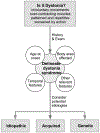Medical and Surgical Treatments for Dystonia
- PMID: 32279713
- PMCID: PMC7156436
- DOI: 10.1016/j.ncl.2020.01.003
Medical and Surgical Treatments for Dystonia
Abstract
The dystonias are a large and heterogenous group of disorders characterized by excessive muscle contractions leading to abnormal postures and/or repetitive movements. Their clinical manifestations vary widely, and there are many potential causes. Despite the heterogeneity, helpful treatments are available for the vast majority of patients. Symptom-based therapies include oral medications, botulinum toxins, and surgical interventions. For some subtypes of dystonia, specific mechanism-based treatments are available. Advances in understanding the biological basis for many types of dystonia have led to numerous recent clinical trials, so additional treatments are likely to become available in the very near future.
Keywords: Blepharospasm; Botulinum toxin; Deep brain stimulation; Meige syndrome; Oromandibular dystonia; Therapy; Torticollis.
Copyright © 2020 Elsevier Inc. All rights reserved.
Conflict of interest statement
Disclosure H.A. Jinnah has active or recent grant support from the US government (National Institutes of Health), private philanthropic organizations (the Benign Essential Blepharospasm Research Foundation, Cure Dystonia Now) and industry (Cavion Therapeutics, Ipsen Pharmaceuticals, Retrophin Inc., and Revance). Dr H.A. Jinnah has also served on advisory boards or as a consultant for Allergan Inc., CoA Therapeutics, Medtronic Inc., and Retrophin Inc. He has received honoraria or stipends for lectures or administrative work from the American Academy of Neurology, the American Neurological Association, the Dystonia Medical Research Foundation, the International Neurotoxin Society, the International Parkinson’s Disease and Movement Disorders Society, The Parkinson’s Disease Foundation, and Tyler’s Hope for a Cure. Dr H.A. Jinnah serves on the Scientific Advisory Boards for several private foundations including the Benign Essential Blepharospasm Research Foundation, Cure Dystonia Now, the Dystonia Medical Research Foundation, the Tourette Association of America, and Tyler's Hope for a Cure. He also is principal investigator for the Dystonia Coalition, which has received the majority of its support through NIH grants NS116025 and NS065701 from the National Institutes of Neurological Disorders and Stroke and previously grant TR 001456 from the Office of Rare Diseases Research at the National Center for Advancing Translational Sciences. The Dystonia Coalition has received additional material or administrative support from industry sponsors (Allergan Inc. and Merz Pharmaceuticals) as well as private foundations (The American Dystonia Society, Beat Dystonia, The Benign Essential Blepharospasm Foundation, Cure Dystonia Now, Dystonia Europe, Dystonia Inc., Dystonia Ireland, The Dystonia Medical Research Foundation, The Foundation for Dystonia Research, The National Spasmodic Dysphonia Association, and The National Spasmodic Torticollis Association).
Figures



References
Publication types
MeSH terms
Grants and funding
LinkOut - more resources
Full Text Sources
Medical

